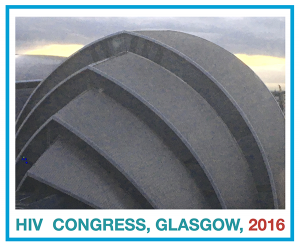Immunology and HIV persistence – implications for a cure
29 November 2016. Related: Conference reports, Cure-related research, HIV 13 Glasgow 2016.
Gareth Hardy, HIV i-Base
Steve Deeks from University California San Francisco and the amfAR Institute for HIV Cure Research presented a review of current strategies aimed at curing HIV. [1]
While numerous approaches are being investigated, a cure for HIV is likely to need multiple approaches. However, large combined studies might begin within five years.
Deeks framed his talk with the proposition that for an HIV cure to have a global impact it must meet five conditions, as described in a modelling study conducted by Andrew Phillips using data from Zimbabwe [2].
- Durable efficacy. A cure may allow wiggle room for viral failure in the short term (which would be picked up by monitoring), but not if it fails after longer periods which could mimic seroconversion and dramatically increase risk of transmission.
- The product. This must be oral/parental and administered over a limited period of up to 6 months and not requiring specialised care.
- Target population. Likely when ART has been started in early infection.
- Safety. This should be comparable to current ART and maintain negligible transmission risk.
- Cost. Upper cost of cost estimated at $1400 per intervention.
The four most promising approaches to develop such a viable cure are not all conducive to global impact.
- Gene and cell based therapies would build an HIV resistant immune system or excise integrated HIV, but are expensive and likely to have higher risk of difficult side effects.
- Starting ART very early in infection reduces the size of the latent reservoir, but would have limited global impact for most people who are already HIV positive.
- “Shock and kill” strategies aimed at inducing latent HIV with agents such as HDAC inhibitors, to reduce the size of the reservoir.
- Immunotherapies aimed at establishing durable host-mediated control of HIV in the absence of ART.
A major concern with the “shock and kill” approach is that persistence of a small number of cells containing replication competent HIV could reseed systemic infection, which occured in the so called “Boston patients” who remained aviraemic for months before viral breakthrough occurred. [3]
These patients’ viral loads rebounded to 10 million copies/mL with serious consequences, because they had no life-long protective immunity against HIV. Deeks says that this illustrates the need to combine reservoir reduction approaches with immunotherapy, which he suggests presents the best strategy for a viable cure with global impact. The most promising leads in development of immune based therapies come from the field of oncology where similar approaches have had remarkable success in reducing tumor sizes.
Deeks discussed advances in vaccine development and immune based therapies for HIV, which are now tackling the previously significant barriers. These were placed in the context of lessons learned from cancer immunotherapy, which suggest that for durable immune control of HIV to be established, three conditions must be met: (i) low disease/viral burden; (ii) low inflammation; and (iii) sustained tissue resident T cell responses that target immune escape variants.
New promising vaccine approaches that have demonstrated induction of durable T cell responses include the CMV-based vaccine developed by Louis Picker at the Oregon Health and Science University that induces a broad range of aggressive and unconventional CD8 T cell responses. [4]
Furthermore, promising advances have been achieved by using adjuvants that signal through the immune system’s Toll-like receptors (TLRs). These include Gilead’s TLR-7 agonist, GS-9680, that even administered without a vaccine reduced reservoir size and led to immune control in SIV-infected rhesus macaques [unpublished data].
Another critical lesson learned from advances in oncology immunotherapy is that inflammatory environments often activate immune regulatory signalling pathways and can be a substantial hindrance to development of T cell responses. Such pathways include PD-1, CTLA-4, IDO, interleukin-10 (IL-10) and type-I interferon (IFN-I). Inhibitors of these molecules are being developed, some of which are showing promising results in cancer therapy [5].
Deeks finished the talk by explaining that while treat-early, treat-hard strategies may be beneficial for new HIV infections, as demonstrated by the VISCONTI cohort [6], this approach will not help the tens of millions of people who are currently living with HIV. Here he suggests that the most promising approach will be to first reduce the reservoir with latency reversing agents, such as HDAC inhibitors (perhaps by up to 2 logs) – which might be sufficient to allow long-lived, broad HIV-specific T cell responses to maintain control HIV if these responses can be induced by new vaccines, adjuvants and anti-inflammatory agents.
Promisingly, Deeks is optimistic that many of these individual therapies now being tested may be ready for combination use in large clinical trials within the next five years.
References:
- Deeks S. Immunology and HIV persistence-implications for the development of a cure. HIV Glasgow, 23-26 October 2016, Glasgow, UK.
https://vimeo.com/188976430 - Philips A et al. Identifying key drivers of the impact of an HIV cure intervention in sub-Saharan Africa. J Infect Dis, July 2016, 214(1): 73-9.
https://www.ncbi.nlm.nih.gov/pmc/articles/PMC4907418 - Henrich TJ et al. Antiretroviral-free HIV remission and viral rebound after allogeneic stem cell transplantation. Report of 2 cases. Annals Inter Med, 2 Sep 2014, 161(5): 319-27
https://www.ncbi.nlm.nih.gov/pmc/articles/PMC4236912/pdf/nihms639136.pdf (PDF) - Hansen SG et al. Immune clearance of highly pathogenic SIV infection. Nature. 3 Oct 2013; 502(7469):100-4. doi: 10.1038/nature12519. Epub 2013 Sep 11
https://www.ncbi.nlm.nih.gov/pmc/articles/PMC3849456/pdf/nihms512106.pdf - Couzin-Frankel J. Cancer Immunotherapy: Breakthrough of the Year. Science, 20 Dec 2013, 342(6165): 1432-1433.
http://science.sciencemag.org/content/342/6165/1432.full - Sáez-Cirión A et al. Post-treatment HIV-1 controllers with a long-term virological remission after the interruption of early initiated antiretroviral therapy ANRS VISCONTI Study. PLoS Path, Mar 2013, 9(3).
https://www.ncbi.nlm.nih.gov/pmc/articles/PMC3597518/pdf/ppat.1003211.pdf (PDF)


